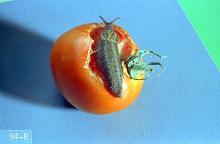Includes
Arion spp.
Black greenhouse slug (Milax gagates)
Gray field slug (Derocerus reticulatum)
Large spotted garden slug (Limax maximus)
Marsh slug (Derocerus laeve)
Reticulated slug (Prophysaon andersoni)
Pest description, crop damage and life history
See:
Common Pests of Vegetable Crops
Management-biological, cultural, tactical
See:
Management-chemical control: HOME USE
Baits are the only registered chemical controls. These must be placed where slugs will encounter them in order to be effective. Baits are required year-round in moist, irrigated areas, but are most effective if placed after fall rains in dry conditions. Rain quickly degrades baits, so reapplication will be required. Cereal-based mini-pellets perform best in the PNW.
- iron phosphate bait-Slower activity than metaldehyde baits, and application rate is three to four times higher than that of metaldehyde. Not registered for use on pumpkin. Some formulations are OMRI-listed for organic use.
- metaldehyde bait-Broadcast to seedbed around borders and between rows. Do not apply directly to plants. Use this product with caution, as it is toxic to pets.
- Sodium ferric EDTA
Management-chemical control: COMMERCIAL USE
- iron phosphate baits at 0.24 to 0.44 lb ai/A. PHI 0 days. REI: no restrictions.
- iron phosphate/spinosad at 0.01 to 0.03 lb ai/A. PHI 3 days. REI 4 hr.
- metaldehyde baits-Do not contaminate edible plant parts. Use as needed but not more than once per week.



